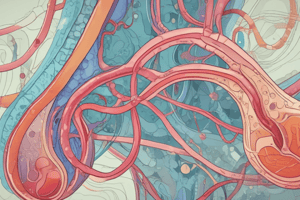Podcast
Questions and Answers
What is the role of the afferent arteriole in the kidney?
What is the role of the afferent arteriole in the kidney?
- It helps in reabsorption at the peritubular capillaries
- It causes constriction of the renal vein
- It is responsible for filtration at the glomerular capillaries (correct)
- It innervates the proximal tubules
Which structure is responsible for the majority of blood flow in the kidneys?
Which structure is responsible for the majority of blood flow in the kidneys?
- Cortical Collecting Duct
- Renal Papilla
- Peritubular capillaries in the cortex (correct)
- Loop of Henle
What would happen if the balance of hydrostatic and oncotic pressures at the glomerular capillaries is disrupted?
What would happen if the balance of hydrostatic and oncotic pressures at the glomerular capillaries is disrupted?
- Only reabsorption would occur
- Excretion would increase
- Only filtration would occur (correct)
- Both filtration and reabsorption would stop
At what arterial blood pressure range do renal blood flow and glomerular filtration rate remain relatively constant?
At what arterial blood pressure range do renal blood flow and glomerular filtration rate remain relatively constant?
Which part of the kidney receives norepinephrine innervation and is mainly affected by it?
Which part of the kidney receives norepinephrine innervation and is mainly affected by it?
What is the formula to calculate excretion in the context of kidney function?
What is the formula to calculate excretion in the context of kidney function?
What is the main function of the afferent arteriole in the kidney?
What is the main function of the afferent arteriole in the kidney?
At what stage does reabsorption primarily occur in the nephron within the kidney?
At what stage does reabsorption primarily occur in the nephron within the kidney?
What would happen if the autoregulation process in the kidney fails?
What would happen if the autoregulation process in the kidney fails?
Which renal structure plays a key role in maintaining blood pressure within the kidney?
Which renal structure plays a key role in maintaining blood pressure within the kidney?
What is the primary function of the vasa recta in the kidney?
What is the primary function of the vasa recta in the kidney?
What happens if there is excessive reabsorption at the peritubular capillaries?
What happens if there is excessive reabsorption at the peritubular capillaries?
What effect does norepinephrine innervation have on blood vessels in the kidney?
What effect does norepinephrine innervation have on blood vessels in the kidney?
Where does most of the blood exiting the glomerulus flow next?
Where does most of the blood exiting the glomerulus flow next?
What would be the impact on renal autoregulation if arterial blood pressure exceeds 140 mmHg?
What would be the impact on renal autoregulation if arterial blood pressure exceeds 140 mmHg?
What is the main purpose of renal autoregulation in maintaining kidney function?
What is the main purpose of renal autoregulation in maintaining kidney function?
Flashcards are hidden until you start studying
Study Notes
Blood Flow and Filtration in the Kidney
- Blood flows through the renal artery, arterial branches, interlobular artery, afferent arteriole, glomerular capillary, efferent arteriole, peritubular capillary, and venous branches before exiting through the renal vein.
- The glomerulus filters blood, forming a filtrate that passes through various tubular structures: Bowman's Capsule, Proximal Tubule, Loop of Henle, Distal Tubule, Cortical Collecting Duct, Medullary Collecting Duct, Renal Papilla, Ureter, Bladder, and exits the body through the urethra.
- The equation for renal function is: [filtration + secretion] – reabsorption = excretion.
Kidney Function and Regulation
- The kidneys receive about 20% of cardiac output, with all blood entering the kidneys passing through a glomerulus.
- Most blood exiting the glomerulus remains in the cortex, flowing through peritubular capillaries, while about 5% flows to the peritubular capillaries in the inner medulla through the vasa recta.
- Renal blood flow and glomerular filtration rate remain relatively constant between arterial blood pressures of 80-140 mmHg due to autoregulation.
- The balance of hydrostatic and oncotic pressures causes filtration to occur at the glomerular capillaries and reabsorption to occur at the peritubular capillaries.
Neural Regulation
- Renal sympathetic nerves (norepinephrine) innervate blood vessels and proximal tubules, with most hemodynamic effect due to afferent arteriole constriction.
Studying That Suits You
Use AI to generate personalized quizzes and flashcards to suit your learning preferences.


